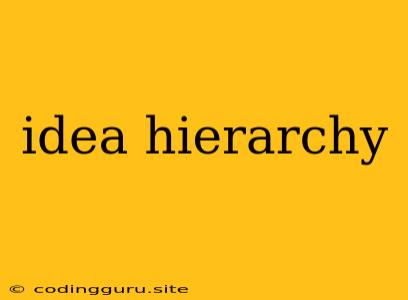Understanding Idea Hierarchy: Organizing Your Thoughts for Clarity and Impact
In the vast ocean of information, we are constantly bombarded with ideas, concepts, and thoughts. It can be overwhelming to navigate this mental landscape, especially when trying to communicate our ideas effectively. This is where the concept of idea hierarchy comes into play.
Idea hierarchy is a powerful tool that helps us organize and structure our thoughts in a logical and meaningful way. It allows us to prioritize information, identify relationships between ideas, and present them in a clear and engaging manner.
What is Idea Hierarchy?
Imagine a pyramid with the most general concept at the top and progressively more specific details branching out towards the bottom. This visual representation captures the essence of idea hierarchy. It's a system of organizing information based on its level of abstraction and its relationship to other ideas.
Why is Idea Hierarchy Important?
Idea hierarchy plays a crucial role in various aspects of communication and problem-solving. Here are some key benefits:
- Clarity and Conciseness: By organizing ideas in a structured manner, idea hierarchy eliminates redundancy and ensures that the most important information is presented first.
- Improved Understanding: When ideas are presented in a logical order, it becomes easier for the audience to follow and understand the flow of information.
- Enhanced Persuasion: By highlighting the key points and providing supporting details, idea hierarchy can make your arguments more persuasive and impactful.
- Effective Problem Solving: By breaking down complex problems into smaller, more manageable components, idea hierarchy facilitates a systematic approach to finding solutions.
Techniques for Creating an Idea Hierarchy
There are several methods to establish an effective idea hierarchy:
- Mind Mapping: This technique uses a visual diagram to connect ideas and explore relationships between them. Start with a central topic and branch out with subtopics, concepts, and details.
- Outlining: This method involves creating a structured list of points, starting with the main idea and then adding supporting details and examples.
- Tree Diagrams: Similar to mind mapping, tree diagrams use a hierarchical structure to visualize the relationships between ideas.
- Flowcharts: These diagrams illustrate the flow of information and processes, highlighting the steps involved in achieving a specific goal.
Examples of Idea Hierarchy in Action
Idea hierarchy is used in a variety of contexts, including:
- Writing: From writing essays to creating presentations, idea hierarchy helps you organize your thoughts and present your ideas effectively.
- Project Management: Project plans often utilize idea hierarchy to break down large projects into smaller tasks and track progress.
- Decision Making: By organizing information into a hierarchy, you can make informed decisions based on a clear understanding of the factors involved.
Tips for Effective Idea Hierarchy
- Start with the Main Idea: Always begin by identifying the central theme or concept you want to convey.
- Use Clear and Concise Language: Use language that is easily understandable and avoids ambiguity.
- Prioritize Information: Focus on the most important points and provide supporting details as needed.
- Visualize the Hierarchy: Use visual aids like mind maps, tree diagrams, or outlines to help you visualize the structure of your ideas.
- Iterate and Refine: Don't be afraid to revise and adjust your idea hierarchy as needed.
Conclusion
Idea hierarchy is a fundamental skill for effective communication and problem-solving. By understanding and applying its principles, you can organize your thoughts, present your ideas clearly, and make a lasting impact on your audience. Whether you're writing an essay, planning a project, or making a decision, idea hierarchy is an invaluable tool for achieving clarity, coherence, and success.
